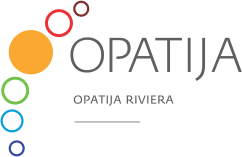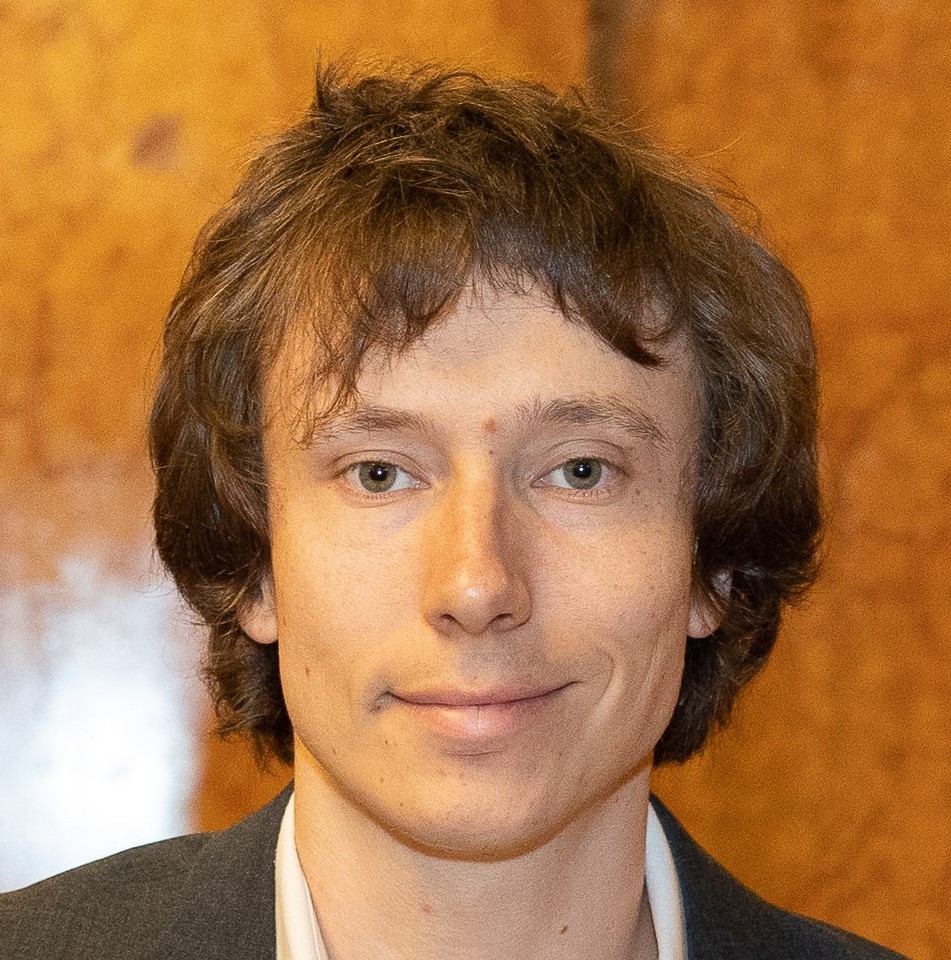|
|
 |
Hybrid Event
|
| Invited Lectures |
Andraž Debevc (Faculty of Electrical Engineering, University of Ljubljana, Slovenia)
Design of Passive Integrated Photonic Components for Optical Coupling and Polarization Handling |
Jonas Junker (Australian National University, Canberra, Australia)
Pulsed 2D Cluster States for CV Quantum Computing
|
Papers |
D. Milovancev (AIT Austrian Institute of Technology, Vienna, Austria)
Monolithically Integrated Switchable Optical Receiver for Classical and Quantum Communication 
In this work we propose a switchable dual bandwidth optical receiver that can be used for both classical and continuous variable quantum key distribution (CV-QKD) on a monolithic platform for opto-electronic integration. Switchable transimpedance amplifier is designed for dual bandwidth that can be switched between high bandwidth (>10 GHz) for classical and low bandwidth (>1.5 GHz) for quantum communication. Monolithic approach allows integration of photonics on the same chip which allows for low-noise operation as well as reconfigurable configuration between a simple link for on-off keying used for classical and optical heterodyne coherent reception used for quantum communication. The receiver performance for both classical and quantum application is simulated showing very high sensitivity as well as high secure key rates over moderate distances.
|
A. Weiss (Joanneum Research, Pinkafeld, Austria), G. Mohr (Joanneum Research, Weiz, Austria), A. Kröpfl, C. Krutzler (Joanneum Research, Pinkafeld, Austria)
Phosphorescent Markers for Visible Light Sensing Put into Practice 
In our last year’s contribution to MIPRO we showed how phosphorescent markers based on Ruthenium and Platinum complexes can be utilized in combination with Backscattered Visible Light Sensing (BVLS) to perform sensory tasks such as identification or distance estimation in a simplified experimental setup. Based on measuring the decay time after a light stimulus, we showed how the marker was clearly distinguishable from optical reflections of various surroundings. In this manuscript, we present our achieved advancements of this approach towards a first real world application in the field of autonomous robots. In current autonomous robots laser-, wire-, magnetically-controlled or even camera-based systems are used for navigation. In our work, we placed a small 3D-printed element containing only one LED, a photomultiplier and a microcontroller on a robotic platform and phosphorescent markers on certain spots on the room floor. The performed comprehensive real world experiments showed that not only the identification of the different markers was achieved, but that this identification was achieved independent from the ambient lighting conditions ranging from no ambient light to a sunlit room. Discussing our achieved results, we will outline how BVLS with phosphorescent markers can be used in such applications to overcome current limitations or shortcomings of other technologies.
|
M. Tomić (Institute of Technical Sciences of SASA, Belgrade, Serbia), A. Gavrilovic-Wohlmuther (Schoeller-Bleckmann Nitec GmbH, Ternitz, Austria), Z. Djinović (ACMIT Gmbh, Wiener Neustadt, Austria)
Measurement of Wall Thickness in Heat Exchanger Tubes by Simultaneous Use of Low- and High-Coherence Fiber-Optic Interferometry 
Measuring wall thickness (WT) in industrial tubes, pipes, and fittings, such as elbows and tees, is vital for ensuring safety in chemical plants, nuclear facilities, and gas or liquid systems. Wall thinning due to flow-accelerated corrosion and erosion can lead to structural failures, causing leaks of hazardous substances. Current non-destructive testing methods, such as ultrasound and eddy current, require plant shutdowns and manual operation. To address this, we propose a fiber-optic sensing technique for WT measurement in running plant operations, which uses low- and high-coherence interferometry applied simultaneously. The measuring set-up consists of a 3×3 single-mode fiber-optic coupler, with the sensing and the reference arms as multi-turn coils bonded to a monitored tube. A dummy stainless-steel tube (120 mm length, 18 mm OD) with three welded sections of different WT (0.5, 1.0, 1.5 mm) was tested under 0–8 bar air pressure. WT was determined from the strain derived from the low- and high-coherence interference signals. The measured circumferential strain ranges up to 50 for a 5-turn fiber coil.
|
J. Janković, I. Ursa, J. Lončar, J. Vuković (University of Zagreb, Faculty of Electrical Engineering and Computing, Zagreb, Croatia), M. Šprem, I. Skokić, M. Španović, M. Orić (Protostar Labs d.o.o., Osijek, Croatia), V. Galić (Agricultural Institute Osijek and Protostar Labs d.o.o., Osijek, Croatia), F. Novoselnik (Protostar Labs d.o.o., Osijek, Croatia), D. Babić (University of Zagreb, Faculty of Electrical Engineering and Computing, Zagreb, Croatia)
Towards Spectral Data Reduction in Paprika Powder Adulteration Detection 
This paper investigates a well-known food safety problem, namely the adulteration of paprika powder with brick powder. Recently, rapid and non-destructive methods for detecting adulteration using spectrography and hyperspectral imaging have been proposed, the major drawback of which is the large amount of data to be processed and stored. We investigate five simple feature selection methods for the reduction of spectral measurement data to simplify the measurement procedure and speed up data processing. Specifically, we apply the feature selection methods to spectral data of paprika powder and brick powder to identify the most informative spectral bands. The results show that the most informative spectral bands are mostly found in the ranges from 510 to 680 nm and from 760 to 920 nm, and they vary depending on the method used. All other spectral data could be omitted without significantly reducing and in some cases even increasing the classification capability of paprika and brick powder. The highest classification capability of 98.1% is achieved with a data reduction of 82% and thus even exceeds the classification capability of the original, unreduced data set of 96.8%. The highest data reduction of 96.9% can be achieved by selecting only two spectral bands, resulting in a classification capability of 78%. These results show the potential for simpler and more economical solutions for the detection of spice adulteration.
|
S. Sladic (University of Rijeka, Rijeka, Croatia), M. De Santis (University of Campania “Luigi Vanvitelli”, Department of Engineering, Aversa, Italy), E. Zivic (Juraj Dobrila University of Pula, Faculty of Engineering, Pula, Croatia), W. Giernacki (Poznan University of Technology, Poznan, Poland)
Smart PV Power Inverter for Emerging Solar Technologies: Case Study Perovskite Solar Cells 
Smart power inverters are recognized as emerging trend in photovoltaics. Importance of this power converter class include several benefits for photovoltaic systems as additional stability for electrical network, increased security of particular system parts, improved cybersecurity, simultaneous control of several units, remote control, additional sensors integration, etc. Aim of this paper is to investigate this type of inverter in order to decrease disadvantages of emerging solar cell technologies. Such action could include different modes of operation under specific temperature, weather conditions or during the disturbances in electric network in order to achieve a longer life-cycle of overall system and to increase importance of emerging solar cell technologies. Majority of the analysis is targeted to perovskite solar cells as widely recognized emerging trend in photovoltaics. Analysis has been supported by simulations in PLECS software.
|
|
Basic information:
Chairs:
Vera Gradišnik (Croatia), Irena Jurdana (Croatia), Marin Karuza (Croatia), Mario Stipčević (Croatia)
Steering Committee:
Andrea Aiello (Germany), Domenico Caputo (Italy), Duško Čakara (Croatia), Andreja Gajović (Croatia), Nenad Kralj (Croatia), Danjela Kuščer (Slovenia)
Program Committee:
Andrea Aiello (Germany), Domenico Caputo (Italy), Duško Čakara (Croatia), Andreja Gajović (Croatia), Vera Gradišnik (Croatia), Irena Jurdana (Croatia), Marin Karuza (Croatia), Nenad Kralj (Croatia), Danjela Kuščer (Slovenia), Robert Peter (Croatia), Mario Rakić (Croatia), Mario Stipčević (Croatia)
Registration / Fees:
|
REGISTRATION / FEES
|
Price in EUR
|
EARLY BIRD
Up to 23 May 2025 |
REGULAR
From 24 May 2025 |
| Members of MIPRO and IEEE |
270 |
297 |
| Students (undergraduate and graduate), primary and secondary school teachers |
150 |
165 |
| Others |
300 |
330 |
The student discount doesn't apply to PhD students.
NOTE FOR AUTHORS: In order to have your paper published, it is required that you pay at least one registration fee for each paper. Authors of 2 or more papers are entitled to a 10% discount.
Contact:
Vera Gradišnik
University of Rijeka
Faculty of Engineering
Vukovarska 58
HR-51000 Rijeka, Croatia
e-mail: Vera.Gradisnik@uniri.hr
Phone: +385 51 651557
The best papers will get a special award.
Accepted papers will be published in the ISSN registered conference proceedings. Papers presented at the conference will be submitted for inclusion in the IEEE Xplore Digital Library.
Location:
 Opatija is the leading seaside resort of the Eastern Adriatic and one of the most famous tourist destinations on the Mediterranean. With its aristocratic architecture and style, Opatija has been attracting artists, kings, politicians, scientists, sportsmen, as well as business people, bankers and managers for more than 180 years. Opatija is the leading seaside resort of the Eastern Adriatic and one of the most famous tourist destinations on the Mediterranean. With its aristocratic architecture and style, Opatija has been attracting artists, kings, politicians, scientists, sportsmen, as well as business people, bankers and managers for more than 180 years.
The tourist offer in Opatija includes a vast number of hotels, excellent restaurants, entertainment venues, art festivals, superb modern and classical music concerts, beaches and swimming pools – this city satisfies all wishes and demands.
Opatija, the Queen of the Adriatic, is also one of the most prominent congress cities in the Mediterranean, particularly important for its ICT conventions, one of which is MIPRO, which has been held in Opatija since 1979, and attracts more than a thousand participants from over forty countries. These conventions promote Opatija as one of the most desirable technological, business, educational and scientific centers in South-eastern Europe and the European Union in general.
For more details, please visit www.opatija.hr and visitopatija.com.
|
|
|
|
- 3/11/2025
Invited Lecture:
 Andraž Debevc Andraž Debevc
Laboratory of Photovoltaics and Optoelectronics, Faculty of Electrical Engineering, University of Ljubljana, Slovenia
Design of Passive Integrated Photonic Components for Optical Coupling and Polarization Handling 
Abstract
Photonic Integrated Circuits integrate a large number of photonic components and functions onto a single chip, providing numerous benefits such as scalability, enhanced performance, improved reliability, seamless co-integration with electronics, and reduced costs compared to discrete component solutions. In our contribution, we will present the design and experimental results of passive components for coupling and splitting optical signals as well as components that tackle the polarization dependency of integrated waveguides. These components serve as basic building blocks for more complex components such as wavelength filters, light sources, modulators, etc. that are utilized in applications ranging from telecommunications to quantum communications and computing.
- 3/11/2025
Invited Lecture:
 Dr Jonas Junker Dr Jonas Junker
Australian National University, Centre for Gravitational Astrophysics, Canberra, Australia
Pulsed 2D Cluster States for CV Quantum Computing 
Abstract
The success of measurement-based continuous-variable (CV) quantum computing relies on overcoming key experimental challenges, including efficient squeezing generation, loss mitigation, and precise phase control in optical fibres. We present our experimental progress in developing high-efficiency pulsed squeezing, stabilizing fibre links for long-distance optical coherence, and implementing phase-locking techniques to generate a pulsed 2D cluster state. This state lays the groundwork for future implementations of measurement-based quantum computing, including the realization of a scalable Gaussian Boson Sampling experiment.
|
|
|
|
|